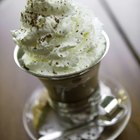morrowlight/iStock/GettyImages
Whipped cream is about as universal as dessert toppings get. It adds richness and moisture to any sweet treat, and it's substantial enough to be piped into rosettes or other decorative shapes. You might have noticed at times that the whipped cream in bakeries tends to hold up better than the kind you whip for yourself at home. Often, that's because of ingredients beyond the usual sugar and vanilla.
Understand the Basics First
Heavy cream's fat content is the reason it holds enough air to whip up into a light froth. Cream is a mixture of milk fat and protein-rich liquid. Ordinarily, the fat keeps to itself in tight balls, or globules, suspended in the liquid. When your whisk whips through the cream, it breaks up those globules and leaves bubbles of air behind. The fragmented fats form new bonds around the air, giving those bubbles some structure. As you continue to whip, the bubbles become finer. The smaller they are, the more stable they remain, until eventually the cream is stiff enough to form long-lasting peaks.
Heavy vs. Light Cream
Any cream with a fat content above 30 percent will whip adequately. In the dairy case you might see light whipping cream with fat content ranging from 30 to 36 percent, and heavy whipping cream with fat content of 38 to 40 percent. Bakers and pastry chefs typically use heavy cream, because its higher fat content means it whips more quickly, and forms a more stable foam. Doing the same at home will improve your whipped cream.
Adding Gelatin
If you need to make up desserts in advance, or if the weather is hot and humid, you can extend the life of your whipped cream by using a stabilizer. One of the simplest is gelatin. Soak 1 tablespoon of unflavored gelatin in 3 tablespoons of cold water until it has absorbed all the water, then microwave it until it's completely dissolved. Let it cool until it's just beginning to thicken. As your whipped cream reaches the soft-peaks stage, pour the cooled gelatin into your mixing bowl in a thin stream. Continue whipping until your cream forms firm peaks, then use it as you normally would. The gelatin will set and help keep your cream from deflating.
Commercial Stabilizers
You can buy commercial cream stabilizers. They come in small envelopes or jars for home bakers, or large buckets for professionals. Some use pectin to thicken the cream, while others use common food additives, such as xanthan gum or guar gum. Others use gelatin in a quick-dissolving form, mixed with other ingredients to prevent clumping. These stabilizers can usually be found in the dairy or baking ingredients section of the supermarket, or sometimes in the produce section near a display of fruit. Some are added to the liquid cream before whipping and others are added during whipping, so check the instructions on the packaging before you begin.
Pastry Cream
Sometimes, bakeries stabilize and flavor their whipped cream by mixing it with another filling, called pastry cream. Pastry cream is a cream-based custard thickened with starch, and it's widely used as the cream filling in cakes, pies and pastries. Because it's thickened with both eggs and starch it's very stable. Folding a small amount of pastry cream into the whipped cream makes it richer, and also helps stabilize the cream and keep it from deflating. This combination is often used in cream puffs and similar desserts.
Related Articles

Heavy Whipping Cream Vs. Half & Half

How to Make Whipped Frosting Without ...

Why Is My Pastry Cream Hardened?

Adding Vanilla Pudding to Whipping Cream
A Substitute for Meringue
Cream vs. Creamer
Clotted Cream Vs. Double Cream
How Can I Prepare Whipping Cream Ahead ...

How to Fix Grainy Whipped Ganache

Why Does Cream Turn Into Butter?

What Does Stabilizing Frosting Mean?

How to Thicken Cream Filling

Different Types of Whipping Cream

How to Harden Up Whipped Cream

Can You Make Homemade Whipped Cream ...

Heavy Cream vs. Milk in Baking

How to Mix Whipped Cream Cheese & ...

How to Soften a Stiff Buttercream

Why Does Milk Curdle When Baking a ...

Adding Cream of Tartar to Macaroons
References
- On Food and Cooking: The Science and Lore of the Kitchen; Harold McGee
- The Professional Pastry Chef; Bo Friberg
- Crafty Baking: Pastry Cream
Writer Bio
Fred Decker is a trained chef and prolific freelance writer. In previous careers, he sold insurance and mutual funds, and was a longtime retailer. He was educated at Memorial University of Newfoundland and the Northern Alberta Institute of Technology. His articles have appeared on numerous home and garden sites including GoneOutdoors, TheNest and eHow.